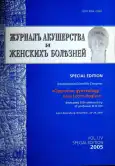Rehabilitation of the reproductive function in patients after intrauterine surgery of hysteromyoma
- Authors: Popov E.N.1,2, Niauri D.A.1,2, Volkov N.N.1,2, Djemlikhanova L.H.1,2
-
Affiliations:
- D.O. Ott Obstetrics and Gynecology Research Institute
- Russian Academy of Medical Sciences
- Issue: Vol 54, No 5S (2005)
- Pages: 93-94
- Section: Reviews
- Submitted: 15.11.2005
- Accepted: 11.11.2021
- Published: 15.11.2005
- URL: https://journals.eco-vector.com/jowd/article/view/87585
- DOI: https://doi.org/10.17816/JOWD87585
- ID: 87585
Cite item
Abstract
Introduction. Modem surgical techniques of hysteroresectoscopy allow to perform organ-preserving operations in patients with submucous hysteromyoma. The submucous node up to 4 cm can be fully excised with electrosurgical fragmentation, if it belongs to the 0 or Ist type of localization according to European Hysteroscopists Association classification.
Full Text
Introduction. Modem surgical techniques of hysteroresectoscopy allow to perform organ-preserving operations in patients with submucous hysteromyoma. The submucous node up to 4 cm can be fully excised with electrosurgical fragmentation, if it belongs to the 0 or Ist type of localization according to European Hysteroscopists Association classification. In the IInd type of localization and the node size over 4 cm preoperative preparation with gonadotropin-releasing hormone (GRH) agonists allows the 20-25% decrease of node size, however, intramural part of the node remains inaccessible to electrosurgical fragmentation and excludes the possibility of pregnancy planning. It raised the issue of the combined use of electrosurgery and laser energy for the ablation of submucous nodes of the IInd type, exceeding 4 cm in size.
Material and Methods. 34 patients of reproductive age with submucous hysteromyoma of the IInd type localization were subjected to surgical operation. Over 50% (18 patients) complained about infertility, and 97% (33 patients) had complaints about hyperpolymenorrhea, accompanied by anemization. The diameter of myomatous nodes ranged from 4,5 to 6 cm, mean 5,7 ± 0,71 cm. The diagnosis of hysteromyoma and localization type of the myomatous node was verified by diagnostic hysteroscopy. Patients received agonist of GRH (Zoladex) for 2 months as preoperative preparation. The suggested surgical technique involved primary electrosurgical fragmentation of the submucous portion of the node with a loop of a “Karl Storz” resectoscope and multifocal laser myolysis of the remaining interstitial portion of the node with the fiber laser guide of the diode laser by “Alcom-Medica”. The treatment of all intramural portion of the node with the laser guide with the intervals of 10 mm, 5-10 mm depth and 20-25 Wt output allows to vaporize the major volume of the node and induces necrobiotic processes in the remaining tissues. Surgery was carried out with endotracheal anesthesia, average duration of surgical operation was 50 ± 12,74 minutes, blood loss did not exceed 50 ml.
Results. The efficacy of laser treatment was evaluated by the decrease in the intramural node portion volume both during the operation and during ultrasound examination after 4-6 months follow-up. The control hysteroscopy after the follow-up period has shown, that in 15 patients the remaining portion of the node was expulsed into the uterine cavity with a transition to the type 0 node, mean size 1,5 ± 0,51 cm; the nodes were ablated with a resectoscope loop. In other 19 patients the use of laser energy caused complete myolysis of intramural portions of the nodes. The ovulatory menstrual cycle has restored in 33 (97%) patients. 18 women had spontaneous pregnancy, and 4 women underwent successful extracorporal fertilization. No complications of pregnancies were noted in any case. There were 16 cases of vaginal deliveries and 6 Cesarean sections because of combined indications.
About the authors
E. N. Popov
D.O. Ott Obstetrics and Gynecology Research Institute; Russian Academy of Medical Sciences
Author for correspondence.
Email: info@eco-vector.com
Department of Obstetrics and Gynecology, Faculty of Medicine
Russian Federation, Saint Petersburg; Saint PetersburgD. A. Niauri
D.O. Ott Obstetrics and Gynecology Research Institute; Russian Academy of Medical Sciences
Email: info@eco-vector.com
Department of Obstetrics and Gynecology, Faculty of Medicine
Russian Federation, Saint Petersburg; Saint PetersburgN. N. Volkov
D.O. Ott Obstetrics and Gynecology Research Institute; Russian Academy of Medical Sciences
Email: info@eco-vector.com
Department of Obstetrics and Gynecology, Faculty of Medicine
Russian Federation, Saint Petersburg; Saint PetersburgL. H. Djemlikhanova
D.O. Ott Obstetrics and Gynecology Research Institute; Russian Academy of Medical Sciences
Email: info@eco-vector.com
Department of Obstetrics and Gynecology, Faculty of Medicine
Russian Federation, Saint Petersburg; Saint PetersburgReferences
Supplementary files






